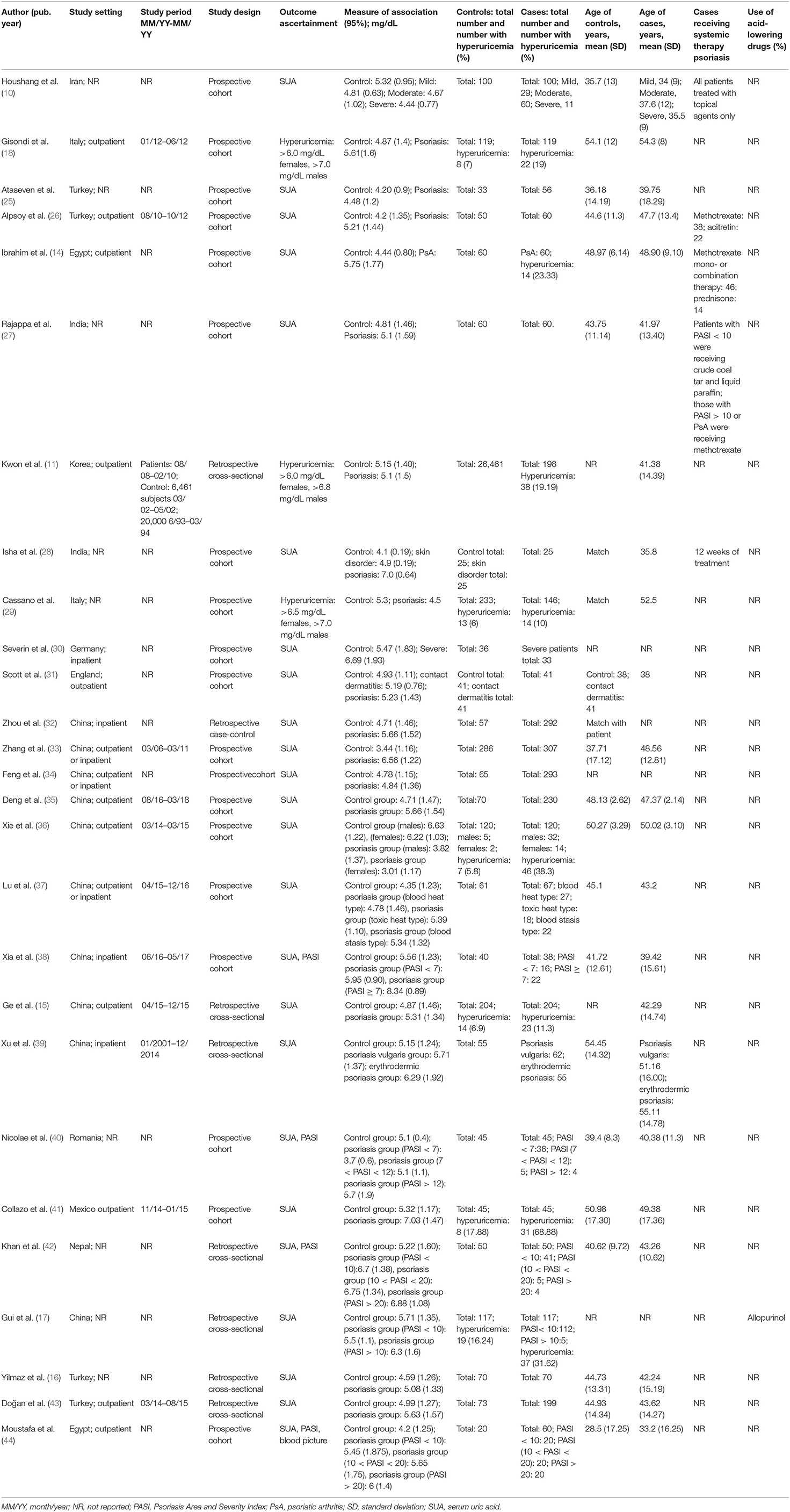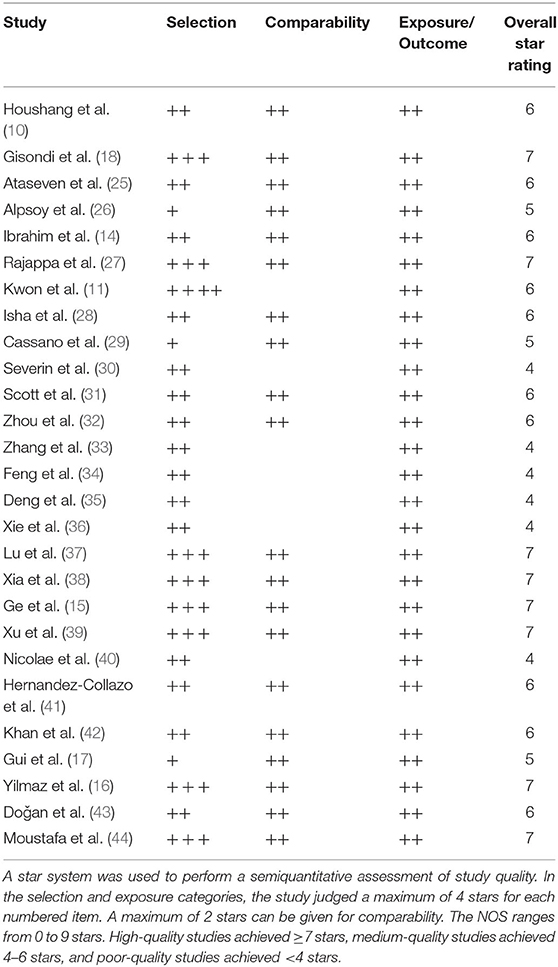- 1Department of Dermatology, Shanghai Skin Disease Hospital, Tongji University, Shanghai, China
- 2Department of Dermatology, Yueyang Hospital of Integrated Traditional Chinese and Western Medicine, Shanghai University of Traditional Chinese Medicine, Shanghai, China
- 3Institute of Dermatology, Shanghai Academy of Traditional Chinese Medicine, Shanghai, China
Background: Our earlier meta-analysis showed that the correlation between psoriasis and hyperuricemia might be region-dependent and that hyperuricemia was more common in patients with psoriasis in Western Europe. However, no further analysis could be conducted owing to the scarcity of data.
Objective: Our study aimed to further explore the association between psoriasis and hyperuricemia.
Methods: Six databases (PubMed, Embase, the Cochrane Central Register of Controlled Trials, the China National Knowledge Infrastructure database, the Chinese Scientific Journals Full Text Database, and the Wanfang Data Knowledge Service Platform) were searched for studies published between January 1980 and February 2021.
Results: The search strategy yielded 291 relevant studies, of which 27 observational studies were included in this analysis. Serum uric acid (SUA) levels (mean difference [MD] 0.99, 95% confidence interval [CI] 0.48–1.49, P = 0.0001) and hyperuricemia frequency (odds ratio [OR] 5.39, 95% CI 1.88–15.40, P = 0.002) were higher in the psoriasis group than in the control group, and the subgroup differences were significant. In addition, SUA levels were significantly higher in patients with moderate to severe psoriasis from European and American countries (MD 0.89, 95% CI 0.18–1.60, P = 0.01) and Southeast Asia (MD 1.79, 95% CI 0.55–3.02, P = 0.004), while no significant differences were found between the Middle East subgroup (MD 0.63, 95% CI −0.33 to 1.59, P = 0.20). Similar results were obtained from the meta-analysis of SUA levels in patients with metabolic syndrome, obesity, or a special type of psoriasis (such as arthritic or erythrodermic psoriasis).
Conclusions: Our meta-analysis study provides extended data regarding the correlation between psoriasis and hyperuricemia and the differences in SUA levels between psoriasis patients and controls in Southeast Asia, the Middle East, and European and American countries. Patients with moderate to severe psoriasis in European and American countries and Southeast Asia or those with metabolic syndrome and obesity were more likely to have higher uric acid levels.
Systematic Review Registration: PROSPERO, identifier: CRD42014015091.
Introduction
Psoriasis is a chronic autoinflammatory disease that affects 2–4% of the population in Western countries (1, 2). It is characterized by keratinocyte hyperproliferation and increased epidermal cell turnover (3). Multiple mechanisms are involved in the pathogenesis of psoriasis, such as the presence of activated dendritic cells and T-lymphocytes, epidermal hyperproliferation, reduced keratinocyte differentiation, and oxidative stress (4–7).
Serum uric acid (SUA) mediates inflammatory pathways via the secretion of proinflammatory chemokines (8). Conversely, it has also been postulated that SUA acts as a potential antioxidant in patients with psoriasis (9, 10). Kwon et al. suggested that increased keratinocyte cell production induces an increase in purine metabolism, which elevates SUA levels in patients with psoriasis (11). According to surveys of SUA in adults in the United States, the normal range of SUA should be between 3.0 and 7.0 mg/dL (12). In 2016, we reported a systematic evaluation of the relationship between psoriasis and SUA level (13). Psoriasis is associated with various disorders such as cardiovascular diseases (14), metabolic syndrome (15, 16), obesity (17, 18), and chronic obstructive pulmonary disease (COPD) (19). Shared inflammatory pathways and common risk factors, such as obesity, glycometabolism disorders, and lipid metabolism disorders, may explain the pathogenesis of comorbidities in patients with psoriasis (2, 20). In a multivariate analysis, Gisondi et al. (18) identified psoriasis as the most important risk factor for hyperuricemia compared with other known risk factors such as obesity or metabolic syndrome. A meta-analysis by Li et al. (19) demonstrated that patients with psoriasis are at greater risk of developing COPD, and this association was stronger in patients with severe psoriasis. Elevated SUA levels have also been associated with outcomes related to metabolic syndrome, such as obesity, cardiovascular diseases, and hypertension. In another study, Li et al. (21) and Chen et al. (22) examined 136 unique associations between SUA level or SUA-lowering treatment and health outcomes and suggested five diseases highly associated with high SUA levels, namely heart failure, hypertension, impaired fasting glucose or diabetes, chronic kidney disease, and coronary heart disease. Considering the potential importance of uric acid, it is necessary to revise the systematic evaluation of the correlation between psoriasis and SUA levels to provide an updated data reference for relevant medical services and clinical interventions.
Materials and Methods
Data Sources and Searches
To identify relevant psoriasis studies in which SUA levels were measured as an outcome, three reviewers (YZ, LL, and XL) systematically searched six databases (PubMed, Embase, the Cochrane Central Register of Controlled Trials, the China National Knowledge Infrastructure database, the Chinese Scientific Journals Full Text Database, and the Wanfang Data Knowledge Service Platform) using the search terms psoriasis, hyperuricemia, and uric acid. Articles published between January 1980 ang February 2021 in English or Chinese were included in this study.
Study Selection
The included publications were selected based on the following inclusion criteria: (1) human-only studies; (2) control group available; (3) original data available; and (4) estimation of the confidence intervals (CIs) by odds ratio (OR), risk ratio, hazard ratio (including enough data to calculate them), and hyperuricemia regarded as a specific outcome event or the mean CIs of SUA available. Initially, 291 articles were included in this study (Figure 1). A manual review of the references lists of the selected publications revealed six additional articles. We carefully reviewed these studies. Finally, 27 studies were included in this systematic review. A flowchart depicting the screening process is presented in Figure 1.
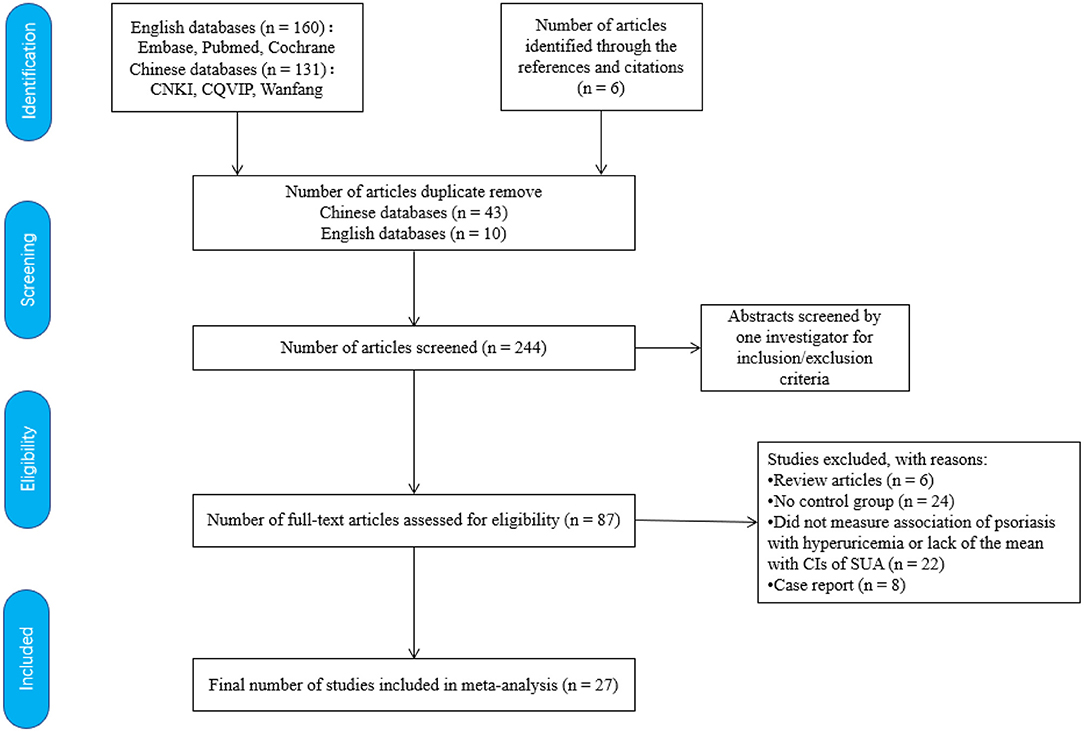
Figure 1. Flowchart of literature search and study selection process. CNKI, the China National Knowledge Infrastructure database; CQVIP, the Chinese Scientific Journals Full Text Database; Wanfang, the Wanfang Data Knowledge Service Platform; CIs, confidence intervals; SUA, serum uric acid.
Data Extraction and Quality Assessment
Three reviewers independently extracted the data using a predefined data extraction form for each included study. The extracted data included the first author, study characteristics, participant characteristics, and outcome characteristics. The Newcastle-Ottawa Scale (23) was used to assess study quality. Using this scale, the case-control studies were divided into selection, comparability, and exposure categories, while cohort studies were divided into selection, comparability, and outcome categories. The selection category contained four quality items: one for comparability and three for exposure.
Data Synthesis and Analysis
The primary outcomes of this study were the differences between healthy controls and patients with psoriasis with respect to mean SUA levels and the relationship between psoriasis and the incidence of hyperuricemia. Cochrane's X2 and I2-tests were used to assess the degree of inter-study heterogeneity. Considerable heterogeneity was identified at P < 0.10 or I2-values above 50%. A random-effects model was used to compute the global OR and mean difference (MD). Fixed-effect models were used to examine studies with P > 0.05 or I2 < 50% or when the intra-study heterogeneity was not substantial. To analyze the possible reasons for the heterogeneity, we used prespecified variables and a random-effects meta-analysis for the subgroup analysis and meta-regression. The subgroups were analyzed based on the severity scales (such as Psoriasis Area and Severity Index [PASI]), sex, psoriasis type, and presence of metabolic disease. Prespecified sources of heterogeneity in the meta-regression included the source population, location, study design, study quality, psoriasis severity, presence of psoriatic arthritis, confirmed outcome, and outcome analysis. The methods and findings of the present review followed the guidelines and checklist of the Meta-analysis of Observational Studies in Epidemiology group (24). Review Manager 5.2 was used for the meta-analysis (http://ims.cochrane.org/revman). The meta-regression was performed using Stata version 15.0 (Stata Corp, College Station, TX, USA).
Results
General Characteristics and Methodology Assessment
Among the 297 identified studies, 27 were selected for inclusion in the systematic review and meta-analysis (Table 1). The meta-analysis consisted of two parts based on the type of response variable. The first part included the 27 studies (10, 11, 14–18, 25–44) that used continuous SUA as the response variable. These studies consisted of 31,314 participants (2,951 with psoriasis and 28,363 controls). The second part included seven studies (15, 17, 18, 29, 33, 36, 41) that had dichotomous hyperuricemia as the response variable. These studies included a total of 2,082 participants (958 with psoriasis and 1,124 controls) who met the inclusion criteria for the dichotomous variables of the systematic review. Of these 27 studies, 19 were cohort and eight were cross-sectional. Twenty-six studies provided means with CIs of SUA levels in psoriasis and control groups. Hyperuricemia was considered a specific outcome event, and ORs were provided in seven studies. Twenty studies suggested a statistically significant difference in SUA levels between psoriasis and control groups. Eleven studies evaluated outpatients. The studies were conducted in Southeast Asia, European and American regions, and the Middle East; among them, 17 were conducted in Asian countries.
Quality Score of Included Studies
The Newcastle-Ottawa Scale scores ranged from 4 to 9 (Table 2). Among the included studies, 19 were considered of medium quality (4–6 stars) and eight were of high quality (≥7 stars).
Primary Outcomes (Continuous Variables)
The meta-analysis of the SUA levels of patients with psoriasis showed significant inter-study heterogeneity (I2 = 98%, P < 0.00001). Specifically, the statistical heterogeneity among each subgroup was high (Middle East I2 = 93%, P < 0.00001; Southeast Asia I2 = 99%, P < 0.00001; and European and American regions I2 = 78%, P = 0.001). Using random-effects modeling, pooling of the results from these trials showed a significant difference in SUA levels between psoriasis patients and controls (MD 0.99, 95% CI 0.48–1.49, P = 0.0001). Although the heterogeneity was high, an optimal subgroup in Southeast Asia (MD 1.20, 95% CI 0.47–1.94, P = 0.001) was identified in a subgroup analysis. In addition, a significant difference was found in the European and American regions (MD 0.83, 95% CI 0.31–1.35, P = 0.002). Specifically, the difference between the Middle East groups almost reached statistical significance (MD 0.63, 95% CI −0.02 to 1.24, P = 0.04) (Figure 2). No statistically significant sources of heterogeneity were revealed in the meta-regression comparison of SUA levels between psoriasis patients and controls (Table 3).
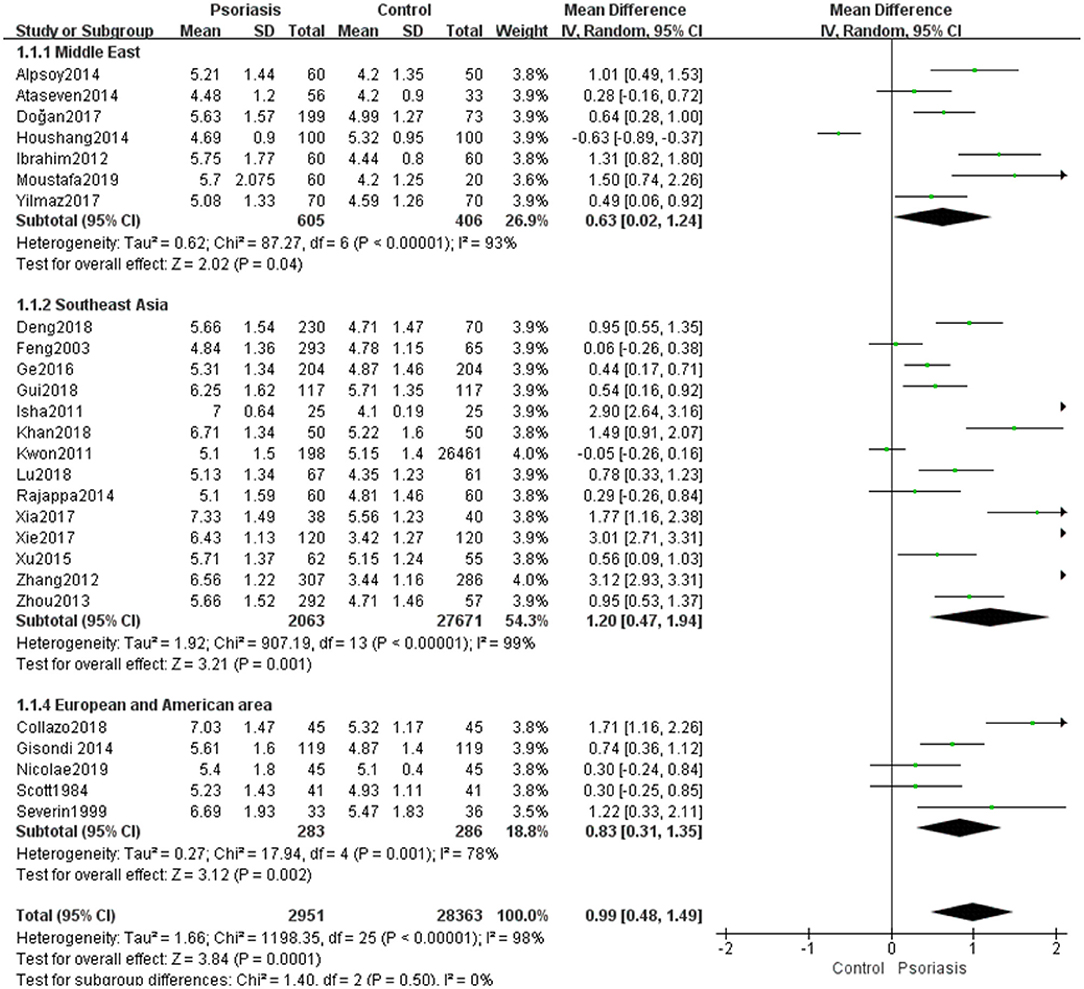
Figure 2. Meta-analysis of the SUA levels of patients with psoriasis vs. controls. The MD in SUA levels of patients with psoriasis compared with controls. The point estimate (center of each green square) and statistical size (proportional area of the square) are represented. The horizontal lines indicate the 95% confidence intervals. The subtotal and total MD (diamond) were calculated using a random-effects model. MD, mean difference; SUA, serum uric acid.
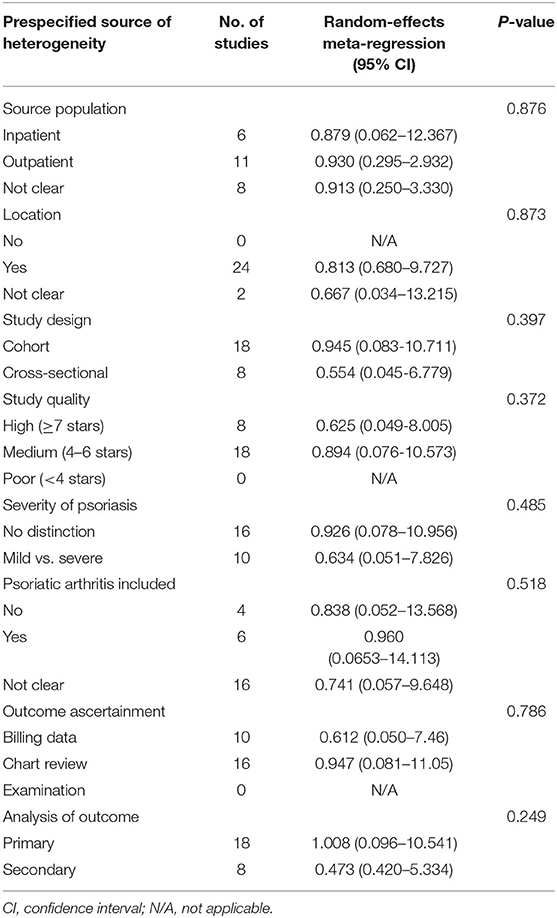
Table 3. Potential prespecified sources of heterogeneity explored among studies reporting SUA levels of patients with psoriasis vs. controls.
Secondary Outcomes
To determine SUA levels in patients with mild and moderate to severe psoriasis, we conducted a meta-analysis of significant inter-study heterogeneity in the mild psoriasis group (I2 = 96%, P < 0.00001) and the moderate to severe psoriasis groups (I2 = 94%, P < 0.00001). Using random-effects modeling, the pooled MD of five studies (10, 17, 38, 42, 44) in the mild psoriasis group was 0.11 (95% CI −0.68 to 0.89; P = 0.79). There was heterogeneity in the Middle East and Southeast Asian subgroups, but no significant differences were observed (MD 0.30, 95% CI −1.42 to 2.02, P = 0.73; MD 0.53, 95% CI −0.46 to 1.51, P = 0.29) (Figure 3). Using random-effects modeling, the pooled MD of nine studies (10, 17, 26, 30, 38, 40, 42–44) in the moderate to severe psoriasis group was determined as 1.04 (95% CI 0.21–1.86, P = 0.01). There was heterogeneity in the Middle East and Southeast Asian subgroups; in the European and American area subgroups, the heterogeneity was small (I2 = 14%, P = 0.28). Significant differences were found in the European and American area subgroups (MD 0.89, 95% CI 0.18–1.60, P = 0.01) and Southeast Asia subgroup (MD 1.79, 95% CI 0.55–3.02, P = 0.004), but not in the Middle East subgroup (MD 0.63, 95% CI −0.33 to 1.59, P = 0.20) (Figure 4). Taken together, these results suggest that in the moderate to severe psoriasis group, the significant difference in SUA levels between psoriasis patients and controls was likely to be clinically or regionally relevant and unlikely to be an artifact resulting from inter-study heterogeneity.
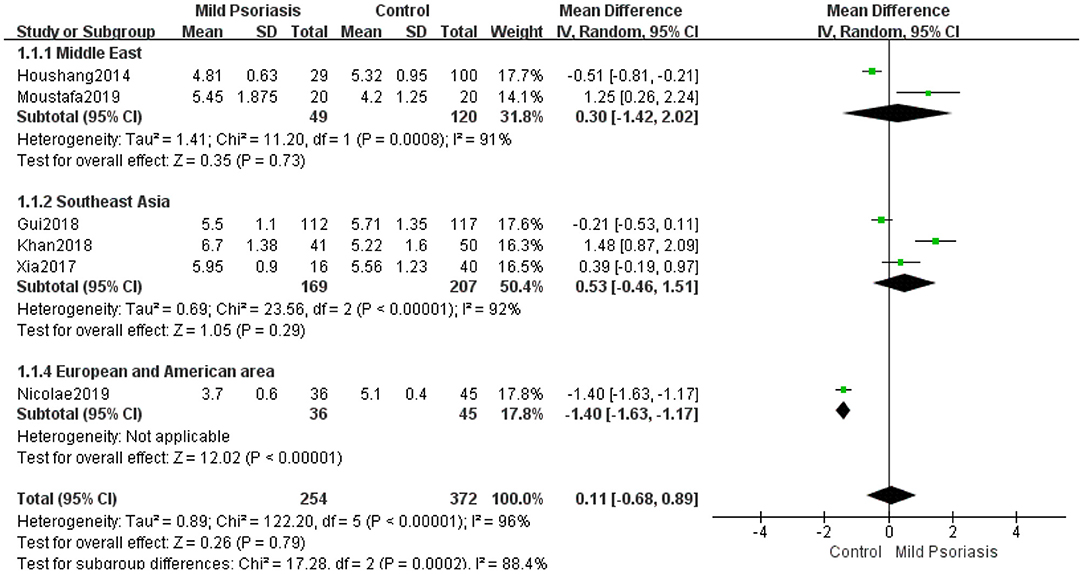
Figure 3. Meta-analysis of the SUA levels of patients with mild psoriasis vs. controls. The MD in SUA levels of patients with mild psoriasis vs. controls. The point estimate (center of each green square) and statistical size (proportional area of the square) are represented. The horizontal lines indicate the 95% confidence intervals. The subtotal and total MD (diamond) were calculated using a random-effects model. MD, mean difference; SUA, serum uric acid.
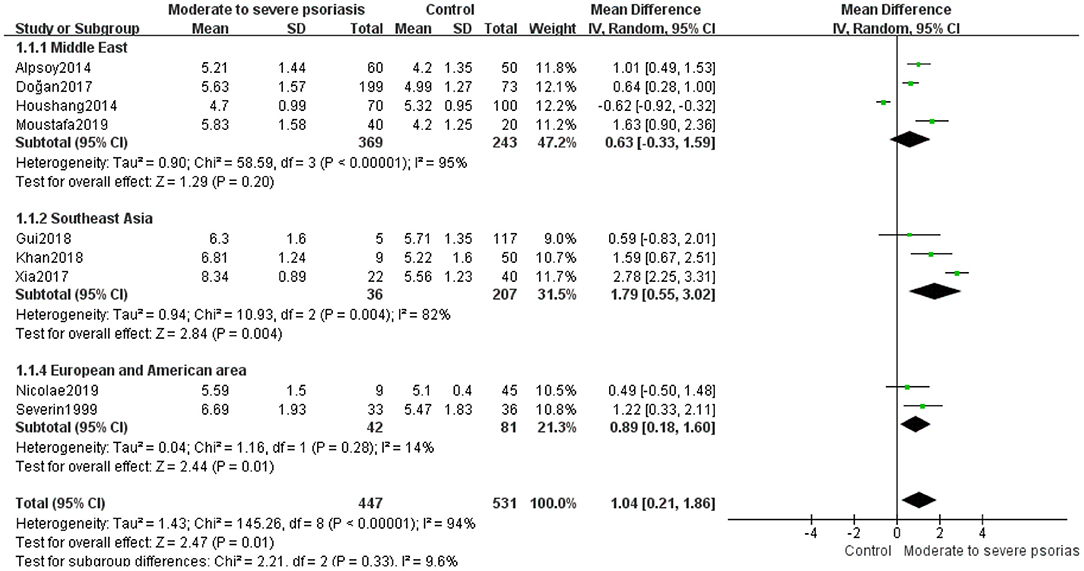
Figure 4. Meta-analysis of the SUA levels of patients with moderate to severe psoriasis vs. controls. The MD in SUA levels of patients with moderate to severe psoriasis vs. controls. The point estimate (center of each green square) and statistical size (proportional area of the square) are represented. The horizontal lines indicate the 95% confidence intervals. The subtotal and total MD (diamond) were calculated using a random-effects model. MD, mean difference; SUA, serum uric acid.
High inter-study heterogeneity existed in the meta-analysis of hyperuricemia occurrences among psoriasis patients and controls from the European and American regions and East Asia (I2 = 73%, P = 0.003). The pooled ORs from the random-effects analysis for seven studies (15, 17, 18, 29, 33, 36, 41) from European and American countries and East Asia, which revealed significant differences in hyperuricemia prevalence between psoriasis patients and controls, was 5.39 (95% CI 1.88–15.40, P = 0.002) (Figure 5).
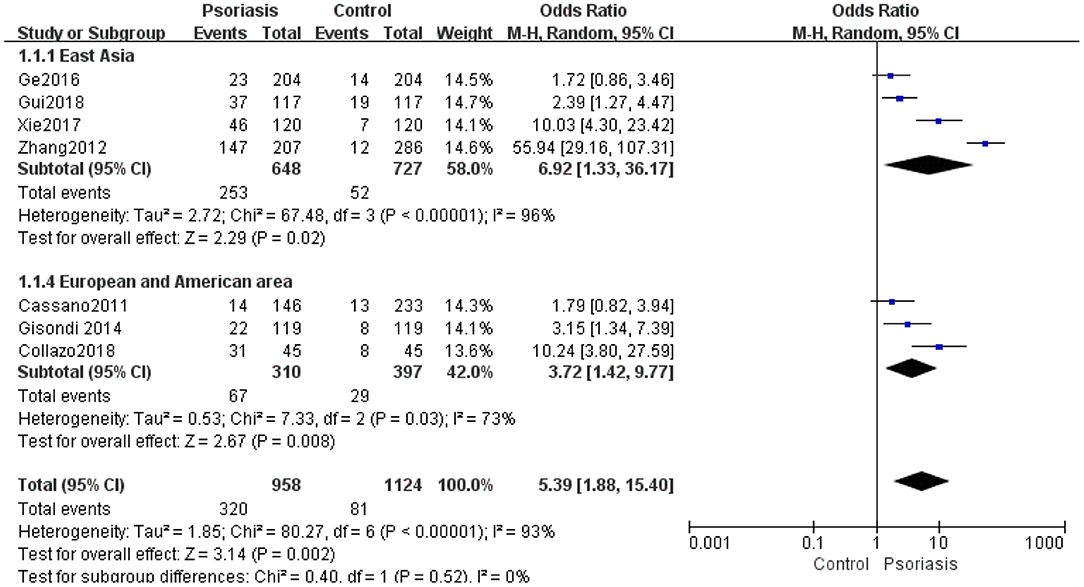
Figure 5. Meta-analysis of the prevalence of hyperuricemia in psoriasis patients vs. controls. OR for psoriasis in patients with hyperuricemia compared with total patients. The point estimate (center of each blue square) and statistical size (proportional area of the square) are represented. The horizontal lines indicate the 95% confidence intervals. The pooled OR (diamond) was calculated using a random-effects model. OR, odds ratio.
Two studies (33, 36) compared SUA levels by sex between psoriasis patients and controls. The results of the meta-analysis using the fixed-effects model (I2 = 50%, P = 0.11) demonstrated little heterogeneity in the female and male subgroups, whereas a significant difference was observed between the two studies with a pooled MD of 3.03 (95% CI 2.87–3.19, P < 0.00001) (Figure 6).
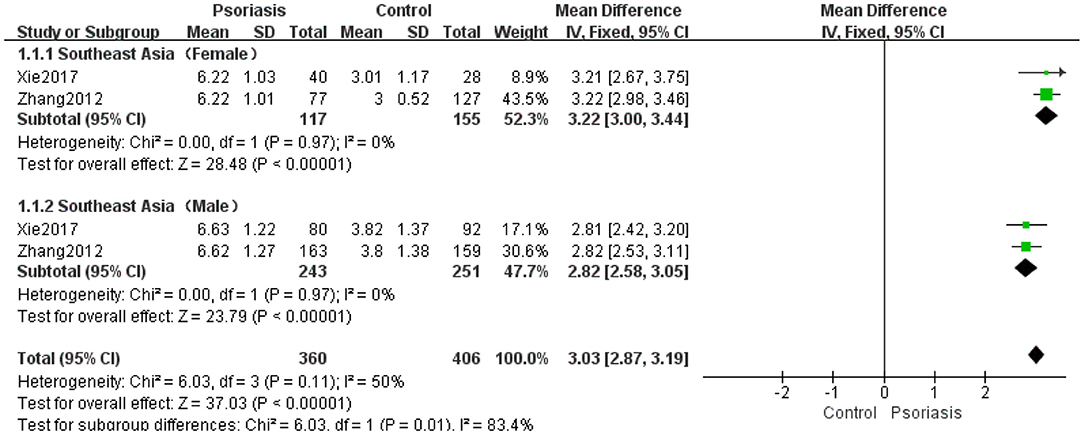
Figure 6. Meta-analysis of the SUA levels of psoriasis patients vs. controls by sex. The MD in SUA levels of psoriasis patients with different genders vs. controls. The point estimate (center of each green square) and statistical size (proportional area of the square) are represented. The horizontal lines indicate the 95% confidence intervals. The subtotal and total MD (diamond) were calculated using a fixed-effects model. MD, mean difference; SUA, serum uric acid.
Two studies (33, 36) analyzed the prevalence of hyperuricemia between the sexes in psoriasis patients and controls. The results of the meta-analysis using the fixed-effects model (I2 = 0%, P = 0.48) indicated that the hyperuricemia prevalence by sex differed significantly between psoriasis patients and controls (OR 16.27, 95% CI 9.89–26.77, P < 0.00001) (Figure 7).
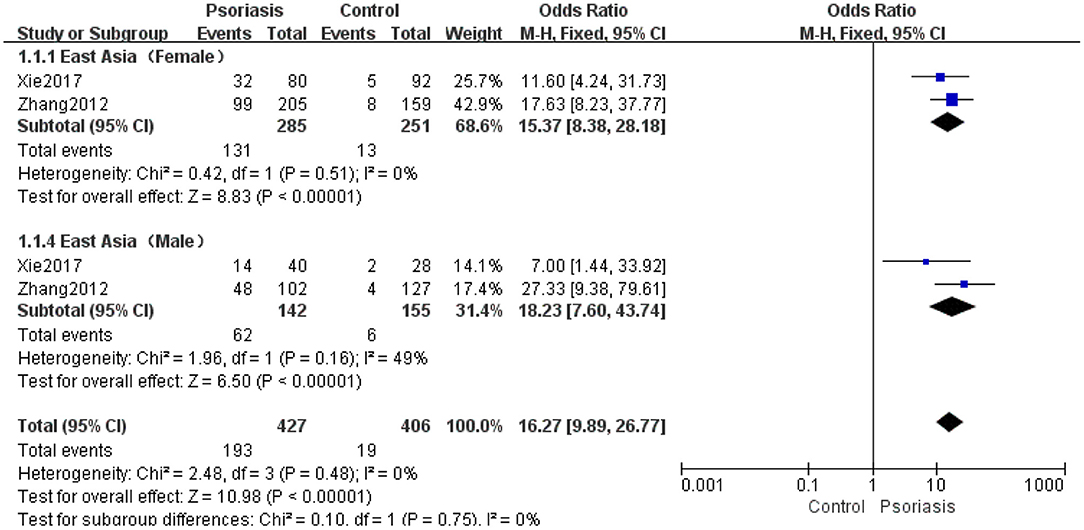
Figure 7. Meta-analysis of the prevalence of hyperuricemia in psoriasis patients vs. controls by sex. OR for psoriasis in subjects with hyperuricemia compared with total subjects. The point estimate (center of each blue square) and statistical size (proportional area of the square) are represented. The horizontal lines indicate the 95% confidence intervals. The pooled OR (diamond) was calculated using a fixed-effects model. OR, odds ratio.
Analysis of SUA levels in each subgroup of patients with a special type of psoriasis like arthritic (14, 36) or erythrodermic (32, 39) showed significant differences between the subgroups (MD 1.19, 95% CI 0.90–1.48, P < 0.00001) using the fixed-effects model (I2 = 40%, P = 0.17). There was heterogeneity in arthritic psoriasis subgroup (I2 = 69%, P = 0.07), little heterogeneity in the subgroup of erythrodermic psoriasis (I2 = 0%, P = 0.35), and significant differences were found in both subgroups (MD 1.05, 95% CI 0.65–1.45, P < 0.0001; MD 1.35, 95% CI 0.92–1.77, P < 0.00001) (Figure 8).
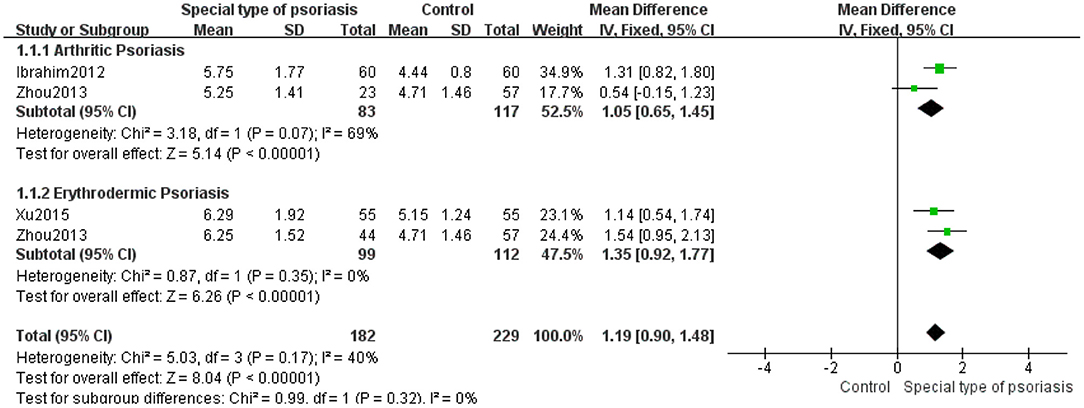
Figure 8. Meta-analysis of the SUA levels of patients with a special type of psoriasis vs. controls. The MD in SUA levels of patients with a special type of psoriasis compared to controls. The point estimate (center of each green square) and statistical size (proportional area of the square) are represented. The horizontal lines indicate the 95% confidence intervals. The subtotal and total MD (diamond) were calculated using a fixed-effects model. MD, mean difference; SUA, serum uric acid.
A meta-analysis of SUA levels among patients with psoriasis who had metabolic syndrome (15, 16) or obesity (18) and controls revealed low inter-study heterogeneity (I2 = 30%, P = 0.24). Using fixed-effects modeling, we observed significant differences in SUA levels between psoriasis patients with metabolic syndrome or obesity and controls in three studies (15, 16, 18), with a pooled MD of 0.86 (95% CI 0.58–1.14, P < 0.00001) (Figure 9).
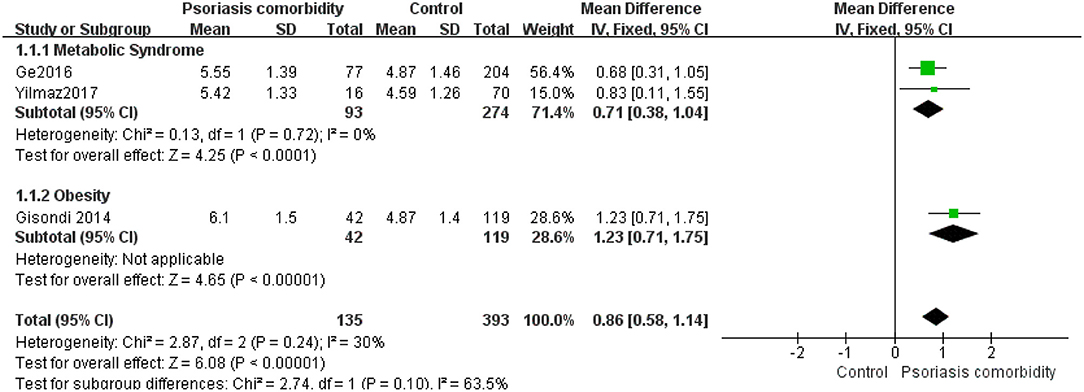
Figure 9. Meta-analysis of the SUA levels of psoriasis patients with comorbidities vs. controls. The MD in SUA levels of psoriasis patients with comorbidities compared to controls. The point estimate (center of each green square) and statistical size (proportional area of the square) are represented. The horizontal lines indicate the 95% confidence intervals. The subtotal and total MD (diamond) were calculated using a fixed-effects model. MD, mean difference; SUA, serum uric acid.
Discussion
Psoriasis is a skin disease that affects people worldwide. While its pathogenesis is unclear, it is believed to be related to several factors, such as heredity, immunity, and environmental factors (16). Clinical research has recognized a correlation between the increase in SUA level and psoriasis (14). In our previous meta-analysis, we assessed data from 14 clinical trials (10, 11, 14, 18, 25, 27–34, 43) including 29,416 patients with psoriasis and concluded that the correlation between psoriasis and hyperuricemia showed a regional pattern and was associated with genetic components and lifestyle differences (13). In this study, we expanded the data from the earlier study to confirm the correlation between psoriasis and hyperuricemia and reveal the potential relevance between morbidity related to some cardiovascular or metabolic diseases and SUA elevation in psoriasis patients.
This meta-analysis combined data from 27 studies that covered most of the available global epidemiological evidence for psoriasis. We analyzed SUA levels in psoriasis patients among different regions, sexes, PASI scale scores, and psoriasis types as well as the presence or absence of metabolic disease. SUA levels and hyperuricemia frequency were significantly higher in the psoriasis group than in the control group. Similar results were obtained when patients were stratified by region, sex, and metabolic disease. In addition, SUA levels in erythrodermic psoriasis and arthritic psoriasis were higher than those in the control group. The MD value of 0 was outside the 95% CI of SUA level in the three subgroups (European and American regions, Southeast Asia, and the Middle East). In seven studies (11, 15, 18, 39, 40, 43, 44), a significant correlation was observed between SUA levels and PASI scores, whereas five studies (27, 28, 34, 36, 42) presented contradictory results. In our study, the stratification of psoriasis patients by PASI score into the mild and moderate to severe psoriasis subgroups revealed that moderate to severe psoriasis patients from European and American regions and Southeast Asia were more likely to have hyperuricemia. No significant correlation was observed between patients with mild psoriasis from the European and American regions, Southeast Asia, or the Middle East and hyperuricemia.
Analysis of the seven studies (15, 17, 18, 29, 33, 36, 41) included in the second part of the meta-analysis showed that the risk of hyperuricemia was high in psoriasis patients. Two studies that performed a subgroup analysis based on sex (33, 36) indicated a significant difference in the prevalence of hyperuricemia between the psoriasis and control groups.
Additionally, the results of this study suggest that elevated SUA levels or hyperuricemia was positively associated with metabolic syndrome (15, 16) and obesity (18). Unfortunately, no cardiovascular disease was mentioned by any of the included studies. Psoriasis is reportedly an independent risk factor for cardiovascular diseases (29, 41). However, the relationship between SUA levels and cardiovascular events in psoriasis is unknown. Ibrahim et al. (14) suggested that chronic systemic inflammation and endothelial dysfunction appear to be the link between asymptomatic hyperuricemia and atherosclerosis. Cassano et al. (29) indicated a trend toward a correlation between SUA level and cardiovascular risk profile in psoriasis patients. Consequently, SUA may be a new marker of atherosclerosis and cardiovascular events in psoriasis patients. Furthermore, high SUA levels are associated with outcomes related to metabolic syndromes, such as obesity and cardiovascular diseases. Yilmaz et al. (16) studied SUA levels in 70 psoriasis patients and determined that SUA levels were higher in patients with psoriasis and metabolic syndrome than in those with psoriasis alone. Obesity is a critical comorbidity of psoriasis. Gisondi et al. (18) reported that SUA levels were significantly higher in obese patients than in non-obese patients with psoriasis. Zheng et al. (45) highlighted the fact that intense physical activity lowered the prevalence of psoriasis by reducing fat accumulation. Our meta-analysis showed that SUA levels were significantly higher in patients with moderate to severe psoriasis in European and American regions and Southeast Asia. Thus, it is worth exploring whether metabolic diseases and the clinical severity of patients with psoriasis are positively correlated in these regions. Therefore, the incidence of metabolic syndrome components should be given more attention when SUA levels increase in psoriasis patients, especially those with high PASI scores.
Notably, SUA levels of patients with arthritic psoriasis or erythrodermic psoriasis were significantly higher than those of controls. However, only one study (15) reported a positive correlation between SUA levels and erythrodermic psoriasis, similar to arthritic psoriasis (33). Elevated SUA level are commonly associated with psoriasis (14), and hyperuricemia predisposes patients to gout arthritis (46). However, the distinction between psoriatic arthritis associated with hyperuricemia and gouty arthropathy with psoriasis is complex. In our study, there were no prospective data on the association between psoriasis and gout. Felten et al. (47) suggested a new line of thinking regarding the convergence of gout and psoriatic arthritis that involved the role of urate crystals, which could prompt a potential new treatment approach (urate-lowering therapy) for refractory psoriatic arthritis.
We evaluated the effects of multiple variables on the meta-regression findings among the included studies by performing a meta-regression analysis to determine the factors underlying high heterogeneity but found no statistically significant difference in outcomes.
In conclusion, the current meta-analysis provided extended data regarding the correlation between psoriasis and hyperuricemia and indicated a difference in SUA levels between psoriasis patientsand controls in Southeast Asia, the Middle East, and European and American regions. Psoriasis patients from East Asia, Europe and America have higher SUA levels and rates of hyperuricemia. Meanwhile, patients with moderate to severe psoriasis in European and American regions and Southeast Asia or those with metabolic syndrome and obesity were more likely to have higher uric acid levels. Increasing attention is being paid to psoriasis comorbidities. The topic of psoriasis comorbidities was reviewed in detail in the 2018 Joint AAD-NPF guidelines (20). Future investigations are needed to establish a well-connected network between comorbidities in psoriasis and hyperuricemia or SUA levels and to prevent further comorbidities as well as disease progression. However, due to the inclusion of large numbers of cross-sectional design and cohort design studies in this meta-analysis, it was not possible to draw any conclusions about causality between psoriasis and elevated SUA levels or hyperuricemia. Nonetheless, all patients with psoriasis should undergo SUA screening by their healthcare providers according to national guidelines, with increased frequency considered for patients with obesity, high PASI scores, and asymptomatic hyperuricemia since elevated SUA levels may play a significant role in the progression of metabolic syndrome, cardiovascular disease, and gout in these patients.
Data Availability Statement
The original contributions presented in the study are included in the article/Supplementary Material, further inquiries can be directed to the corresponding author/s.
Author Contributions
YZ, LL, XS, HL, YW, MZ, and LH had full access to all study data and take responsibility for the analytical integrity and accuracy. YZ, LL, XL, and BL were responsible for the study concept and design. YZ and LL were responsible for the data acquisition. XS, HL, YW, and MZ managed the data extraction. YZ and XL performed the assessment of bias risk. YZ, LL, LH, and XL performed the data analysis and interpretation. YZ drafted the manuscript. LL, XL, and BL, while YZ, LL, XL, and BL provided a critical manuscript review for important intellectual content. YZ and LL performed the statistical analyses. XL and BL supervised the study. All authors contributed to the article and approved the submitted version.
Funding
This work was supported by the National Nature Science Foundation of China [grant numbers: 82074427, 81874470], National Key Research and Development Program of China [grant number: 2018YFC1705305], and the Shanghai Pujiang Talent Plan (No. 2020PJD067).
Conflict of Interest
The authors declare that the research was conducted in the absence of any commercial or financial relationships that could be construed as a potential conflict of interest.
Supplementary Material
The Supplementary Material for this article can be found online at: https://www.frontiersin.org/articles/10.3389/fmed.2021.645550/full#supplementary-material
Abbreviations
AAD-NPF, American Association of Dermatologists and the National Psoriasis Foundation; CI, confidence interval; COPD, chronic obstructive pulmonary disease; MD, mean difference; OR, odds ratio; PASI, Psoriasis Area and Severity Index; SUA, serum uric acid.
References
1. Gudjonsson JE, Elder JT. Psoriasis: epidemiology. Clin Dernatal. (2007) 25:535–46. doi: 10.1016/j.clindermatol.2007.08.007
2. Takeshita J, Grewal S, Langan SM, Mehta NN, Ogdie A, Van Voorhees AS, et al. Psoriasis and comborbid diseases: epidermiology. J Am Acad Dermatol. (2017) 76:377–90. doi: 10.1016/j.jaad.2016.07.064
3. Goldman M. Uric acid in the etiology of psoriasis. Am J Dermatopathol. (1981) 3:397–404. doi: 10.1097/00000372-198100340-00014
4. Murari K, Ray AS, Lodha RS. Adenosine deaminase: a potential biomarker for evaluating the severity of psoriasis. Int J Pharma Bio Sci. (2015) 6:629–34.
5. Nwabudike LC, Tatu AL. Reply to Happle R. And al. Koebners sheep in Wolf's clothing: does the isotopic response exist as a distinct phenomenon? J Eur Acad Dermatol Venereol. (2018) 32:336–7. doi: 10.1111/jdv.14900
6. Batani A, Brănişteanu DE, Ilie MA, Boda D, Ianosi S, Ianosi G, et al. Assessment of dermal papillary and microvascular parameters in psoriasis vulgaris using in vivo reflectance confocal microscopy. Exp Ther Med. (2018) 15:1241–6. doi: 10.3892/etm.2017.5542
7. Caruntu C, Boda D, Dumitrascu G, Constantin C, Neagu M. Proteomics focusing on immune markers in psoriatic arthritis. Biomarkers Med. (2015) 9:513–28. doi: 10.2217/bmm.14.76
8. Grainger R, McLaughlin RJ, Harrison AA, Harper JL. Hyperuricaemia elevates circulating CCL2 levels and primes monocyte trafficking in subjects with intercritical gout. Rheumatology. (2013) 52:1018–21. doi: 10.1093/rheumatology/kes326
9. Shindo Y, Witt E, Han D, Packer L. Enzymic and non-enzymic antioxidants in epidermis and dermis of human skin. J Invest Dermatol. (1994) 102:122–4. doi: 10.1111/1523-1747.ep12371744
10. Nemati H, Khodarahmi R, Sadeghi M, Ebrahimi A, Rezaei M, Vaisi-Raygani A. Antioxidant status in patients with psoriasis. Cell Biochem Funct. (2014) 32:268–73. doi: 10.1002/cbf.3011
11. Kwon HH, Kwon IH, Choi JW, Youn JI. Cross-sectional study on the correlation of serum uric acid with disease severity in Korean patients with psoriasis. Clin Exp Dermatol. (2011) 36:473–8. doi: 10.1111/j.1365-2230.2010.03988.x
12. Stone ML, Richardson MR, Guevara L, Rand BG, Churilla JR. Elevated serum uric acid and self-reported heart failure in US Adults: 2007-2016 National Health and Nutrition Examination Survey. Cardiorenal Med. (2019) 9:344–53. doi: 10.1159/000502438
13. Li X, Miao X, Wang HS, Wang YF, Li FL, Yang Q, et al. Association of serum uric acid levels in psoriasis a systematic review and meta-analysis. Medicine. (2016) 95:e3676. doi: 10.1097/MD.0000000000003676
14. Ibrahim SE, Helmi A, Yousef TM, Hassan MS, Farouk N. Association of asymptomatic hyperuricemia and endothelial dysfunction in psoriatic arthritis. Egypt Rheumatol. (2012) 34:83–89. doi: 10.1016/j.ejr.2012.03.002
15. Ge D. Clinical Investigation and TCM Syndromes Study on the Psoriasis vulgaris With Metabolic Syndrome. Nanjing: Nanjing University of Chinese Medicine (2016).
16. Yilmaz E, Tamer E, Artüz F, Külcü Çakmak S, Köktürk F. Evaluation of serum uric acid levels in psoriasis vulgaris. Turk J Med Sci. (2017) 47:531–4. doi: 10.3906/sag-1512-5
17. Gui XY, Jin HZ, Wang ZJ, Xu TD. Serum uric acid levels and hyperuricemia in patients with psoriasis: a hospital-based cross-sectional study. An Bras Dermatol. (2018) 93:761–3. doi: 10.1590/abd1806-4841.20187547
18. Gisondi P, Targher G, Cagalli A, Girolomoni G. Hyperuricemia in patients with chronic plaque psoriasis. J Am Acad Dermatol. (2014) 70:127–30. doi: 10.1016/j.jaad.2013.09.005
19. Li X, Kong LJ, Li FL, Chen C, Xu R, Wang HS, et al. association between psoriasis and chronic obstructive pulmonary disease: a systematic review and meta-analysis. PLoS ONE. (2015) 10:e0145221. doi: 10.1371/journal.pone.0145221
20. Elmets CA, Leonardi CL, Davis DMR, Gelfand JM, Lichten J, Mehta NN, et al. Joint AAD-NPF guidelines of care for the management and treatment of psoriasis with awareness and attention to comorbidities. J Am Acad Dermatol. (2019) 80:1073–113. doi: 10.1016/j.jaad.2018.11.058
21. Li X, Meng XR, Timofeeva M, Tzoulaki I, Tsilidis KK, Ioannidis JP, et al. Serum uric acid levels and multiple health outcomes: umbrella review of evidence from observational studies, randomised controlled trials, and Mendelian randomisation studies. BMJ. (2017) 357:j2376. doi: 10.1136/bmj.j2376
22. Chen X, Hong S, Sun XY, Xu WB, Li HJ, Ma T, et al. Efficacy of fish oil and its components in the management of psoriasis: a systematic review of 18 randomized controlled trials. Nut Rev. (2020) 78:827–40. doi: 10.1093/nutrit/nuz098
23. Stang A. Critical evaluation of the Newcastle–Ottawa scale for the assessment of the quality of nonrandomized studies in meta-analyses. Eur J Epidemiol. (2010) 25:603–5. doi: 10.1007/s10654-010-9491-z
24. Stroup DF, Berlin JA, Morton SC, Olkin I, Williamson GD, Rennie D, et al. Meta-analysis of observational studies in epidemiology: a proposal for reporting. Metaanalysis of Observational Studies in Epidemiology (MOOSE) group. JAMA. (2000) 283:2008–12. doi: 10.1001/jama.283.15.2008
25. Ataseven A, Kesli R, Kurtipek GS, Ozturk P. Assessment of lipocalin 2,clusterin, soluble tumor necrosis factor receptor-1, interleukin-6,homocysteine, and uric acid levels in patients with psoriasis. DisMarkers. (2014) 2014:541709. doi: 10.1155/2014/541709
26. Alpsoy S, Akyuz A, Erfan G, Akkoyun DC, Topcu B, Guzel S, et al. Atherosclerosis, some serum inflammatory markers in psoriasis. Giornale Ital Dermatol Venereol. (2014) 149:167–75.
27. Rajappa M, Rathika S, Munisamy M, Chandrashekar L, Thappa DM. Effect of treatment with methotrexate and coal tar on adipokine levels and indices of insulin resistance and sensitivity in patients with psoriasis vulgaris. J Eur Acad Dermatol Venereol. (2015) 29:69–76. doi: 10.1111/jdv.12451
28. Jain VK, Lal H. C-reactive protein and uric acid levels in patients with psoriasis. Indian J Clin Biochem. (2011) 26:309–11. doi: 10.1007/s12291-011-0132-4
29. Cassano N, Carbonara M, Panaro M, Vestita M, Vena GA. Role of serum uric acid in conditioning the association of psoriasis with metabolic syndrome. Eur J Dermatol. (2011). 21:808–9. doi: 10.1684/ejd.2011.1478
30. Severin E, Nave B, Ständer M, Ott R, Traupec H. Total antioxidative capacity is normal in sera from psoriasis patients despite elevated bilirubin, tocopherol and urate levels. Dermatology. (1999) 198:336–9. doi: 10.1159/000018171
31. Scott JT, Stodell MA. Serum uric acid levels in psoriasis. Adv Exp Med Biol. (1984) 165:283–5. doi: 10.1007/978-1-4684-4553-4_55
32. Zhou Z, Chen JK, Zhou R, Hong YY, Shi J, Hou Y, et al. The study of characteristics of hematological and biochemical parameters in patients with psoriasis and their values in its diagnosis and treatment. Int J Lab Med. (2013) 34:1679–81.
33. Zhang DL, Luo W, Wang J, Shen Y. The level of detection and significance of serum uric acid in patients with psoriasis. J Practical Dermatol. (2012) 5:132–4.
34. Feng WL, Wang L, Jin SY, Zhu AP. Measurement and analysis of serum uric acid levels in patients with psoriasis. Chin J Dermatol. (2003) 36:167.
35. Deng ZW. The value of the changes of hematology indexes in the diagnosis and treatment of psoriasis. Anti Infect Pharm. (2018) 15:1170–2.
36. Xie H, Zhou XH, Guo Y, Bi YF, Yuan LM, Luan CY. Level of uric acid and lipid metabolism in 120 patients with psoriasis and their clinical diagnostic significance. J Clin Med Practice. (2017) 21:109–11.
37. Lu YH, Chen AM, Feng JQ, Zhuang LH, Huang QZ, Zhang LK, et al. Study on homocysteine and uric acid in the differentiation of TCM syndrome with psoriasis vulgaris. Chin J Dermato Venerol Integ Trad W Med. (2018) 17:208–10.
38. Xia DM, Xu JX, Cheng JN, Xiong X. The clinical significance of blood relevant parameters in psoriasis vulgaris. J Appl Med. (2017) 33:4061–4.
39. Xu GX. Retrospective Analysis of the Indicators of Metabolic Diseases in Erythrodermic Psoriasis. Jinan: Shandong University (2015).
40. Nicolae I, Tampa M, Ene CD, Mitran CI, Mitran MI, Sarbu MI, et al. Correlations between related-purine derivatives and renal disorders in patients with psoriasis vulgaris. Exp Therap Med. (2019) 17:1012–9. doi: 10.3892/etm.2018.7053
41. Hernandez-Collazo AA, Villanueva-Quintero G, Rodríguez-Castellanos MA, Poletti-Vázquez ED, Alvarado-Navarro A. Uric acid as a marker of clinical severity and comorbidities in plaque psoriasis. Gaceta Medica de Mexico. (2018) 154:357–61. doi: 10.24875/GMM.M18000168
42. Khan SA, Agrawal S, Baral N, Lamsal M. Evaluation of ADA activity as a potential marker of disease severity in psoriasis patients. Psoriasis. (2018) 8:59–63. doi: 10.2147/PTT.S174119
43. Doǧan S, Atakan N. Red blood cell distribution width is a reliable marker of inflammation in plaque psoriasis. Acta Dermatovenerol Croat. (2017) 25:26–31.
44. Moustafa YM, Elsaied MA, Abd-Elaaty EM, Elsayed RA. Evaluation of serum adenosine deaminase and inflammatory markers in psoriatic patients. Indian J Dermatol. (2019) 64:207–12. doi: 10.4103/ijd.IJD_420_17
45. Zheng Q, Sun XY, Miao X, Xu R, Ma T, Li X, et al. Association between physical activity and risk of prevalent psoriasis: a MOOSE-compliant meta-analysis. Medicine. (2018) 97:e11394. doi: 10.1097/MD.0000000000011394
46. Chandran V, Raychaudhuri SP. Geoepidemiology and environmental factors of psoriasis and psoriatic arthritis. J Autoimmun. (2010) 34:J314–21. doi: 10.1016/j.jaut.2009.12.001
Keywords: psoriasis, hyperuricemia, meta-analysis, metabolic syndrome, obesity, gout
Citation: Zhang Y, Liu L, Sun X, Li H, Wang Y, Zhou M, Hua L, Li B and Li X (2021) Updated Evidence of the Association Between Elevated Serum Uric Acid Level and Psoriasis. Front. Med. 8:645550. doi: 10.3389/fmed.2021.645550
Received: 03 February 2021; Accepted: 03 June 2021;
Published: 29 June 2021.
Edited by:
Youwen Zhou, University of British Columbia, CanadaReviewed by:
Robert Stewart Dawe, NHS Tayside, United KingdomChanghe Yu, Beijing University of Chinese Medicine, China
Copyright © 2021 Zhang, Liu, Sun, Li, Wang, Zhou, Hua, Li and Li. This is an open-access article distributed under the terms of the Creative Commons Attribution License (CC BY). The use, distribution or reproduction in other forums is permitted, provided the original author(s) and the copyright owner(s) are credited and that the original publication in this journal is cited, in accordance with accepted academic practice. No use, distribution or reproduction is permitted which does not comply with these terms.
*Correspondence: Xin Li, MTM2NjE5NTYzMjZAMTYzLmNvbQ== orcid.org/0000-0003-2525-9679; Bin Li, MTg5MzA1NjgxMjlAMTYzLmNvbQ==
†These authors have contributed equally to this work
 Ying Zhang1†
Ying Zhang1† Liu Liu
Liu Liu Xiaoying Sun
Xiaoying Sun Hongjin Li
Hongjin Li Bin Li
Bin Li Xin Li
Xin Li